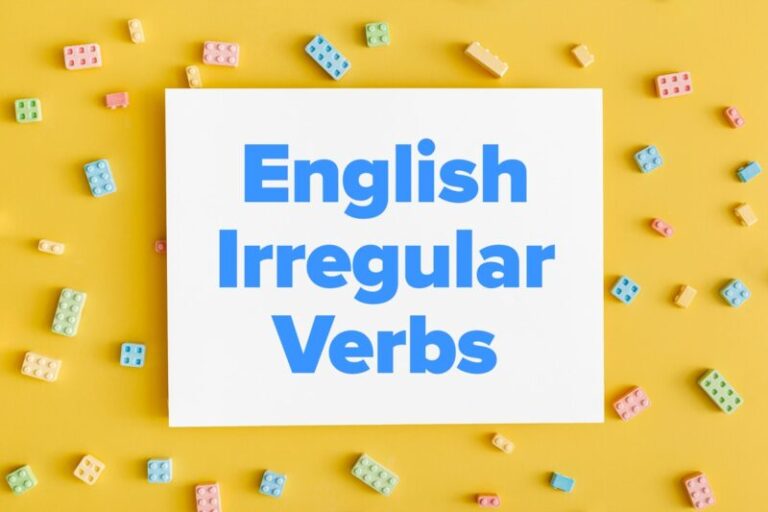Contents
- What is an Infinitive and a Gerund?
- Simple Rules to Master the Use of Gerunds and Infinitives
- Rule 1: Gerunds can be used as a subject of a sentence
- Rule 2: Both gerunds and infinitives can be used as objects of a sentence
- Rule 3: Infinitives should be used after many adjectives
- Rule 4: Only infinitives are used after certain verbs followed by nouns or pronouns referring to a person
- Rule 5: Only gerunds are used after prepositions (with one exception)
- And One More Thing...
When to Use Gerunds and Infinitives: 5 Simple Rules for English Learners

Gerunds and infinitives are very common in the English language. But how do you know when to use an infinitive and when to use a gerund?
The five simple rules below are sure to help.
Download: This blog post is available as a convenient and portable PDF that you can take anywhere. Click here to get a copy. (Download)
What is an Infinitive and a Gerund?
An infinitive is the verb form that has “to” at the beginning. For example, “to do,” “to sleep,” “to love” and “to create.” It is the simplest verb form that you have to modify to fit into sentences.
For example, “She sleeps” no longer contains the infinitive of the verb “to sleep.” Instead, it has been conjugated into the simple present third person form of the verb “to sleep”: sleeps.
Infinitives are easy!
How about gerunds?
Gerunds are formed by adding “-ing” to the verb: “sleeping,” “drawing,” “swimming.” But they are not the “-ing” verb forms that you see in the present or past continuous tense. They look the same, but gerunds are actually verb forms used as nouns.
Let’s take the infinitive of the verb “to sleep” and use it in two different sentences:
I am sleeping.
This is the present continuous. “Sleeping” here is part of the verb. It is not a gerund. Here’s the second sentence:
I don’t like sleeping.
This is present simple, but it contains a gerund. “Sleeping” is the direct object of this sentence.
Now that you know the difference between infinitives and gerunds, let’s introduce the rules that will help you use both correctly.
While the rules below will help you understand how infinitives and gerunds should be used, you should make sure to practice them so you can use them in real life. One easy way to do this is by learning with FluentU videos.
FluentU takes authentic videos—like music videos, movie trailers, news and inspiring talks—and turns them into personalized language learning lessons.
You can try FluentU for free for 2 weeks. Check out the website or download the iOS app or Android app.
P.S. Click here to take advantage of our current sale! (Expires at the end of this month.)

Simple Rules to Master the Use of Gerunds and Infinitives
Rule 1: Gerunds can be used as a subject of a sentence
Take a look at some examples.
Walking is good for your health.
Making friends has become more difficult since I moved to a new city.
Becoming a millionaire is a dream of many young people today.
Here, the gerunds (in bold) are part of the sentence subjects (“walking,” “making friends,” “becoming a millionaire”). All three sentences sound like normal, everyday English.
Now read these two sentences:
“To be or not to be—that is the question.”
“To mourn a mischief that is past and gone is the next way to draw new mischief on.”
(Both sentences are quotes from William Shakespeare’s works.)
They sound formal, don’t they? They are poetic, aren’t they? Shakespeare is one of the greatest authors of all time, but his English is famously difficult to understand. And that’s because it is literature. It is formal and it is art.
In those two quotes, the infinitives “to be” and “to mourn” are used as the sentence subjects.
So, it is possible to use both infinitives and gerunds as subjects, but gerunds are much more commonly used as subjects. Just pay attention to how the choice reflects on the tone and meaning of your sentences.
Rule 2: Both gerunds and infinitives can be used as objects of a sentence
You may say:
“I enjoy drawing.”
You may also say:
“Yesterday, I decided to draw.”
Both sentences are correct, but one has an infinitive as the object and the other has a gerund as the object.
What is the difference?
It’s the verbs that precede (come before) the object! Some verbs require a gerund and some will require an infinitive. In the above examples, we can see that the formula is “enjoy” + [gerund] and “decide” + [infinitive].
With practice, you will be able to remember which one is which.
Here are a few examples of verbs that need to be followed by an infinitive:
- agree: I agreed to go to a party with my friend.
- decide: The president decided not to participate in the discussions.
- deserve: Everyone deserves to be respected.
- expect: I expect to know my exam grade by tomorrow.
- hope: We were hoping to avoid traffic by leaving early.
- learn: He learned not to trust anyone.
- need: She needs to learn how to cook.
- offer: I offered to help my brother with homework.
- plan: We are planning to watch a movie tonight.
- promise: My friend promised to find the time to help me move.
- seem: We seem to be lost.
- wait: I cannot wait to see my family.
- want: I don’t want to go to bed yet.
There are lots of verbs that require an infinitive after. You will learn them naturally, as you progress in your English studies.
And here are a few examples of verbs that need to be followed by a gerund:
- admit: They admitted changing the schedule.
- advise: I advise proceeding (moving forward) with caution.
- avoid: She avoided looking me in the eye.
- consider (think about): I considered staying silent, but I had to tell her.
- deny: I denied knowing about his secret.
- involve: The course involved writing three tests.
- mention (say something): She mentioned seeing my brother at a baseball game.
- recommend: I recommend practicing gerunds and infinitives.
- risk: Don’t risk losing your job!
- suggest: I suggest reading more English short stories.
Rule 3: Infinitives should be used after many adjectives
Here are three sample sentences that will help to illustrate this rule:
It is not easy to graduate from university.
It is necessary to speak English to work in a hotel.
It is wonderful to have close friends.
When you describe something with an adjective (underlined in the examples above), an infinitive should follow (in bold). Using gerunds here would be incorrect.
But remember! If you want to make that object into a subject (see Rule 1), a gerund should be used:
Graduating from university is not easy.
Speaking English is necessary to work in a hotel.
Having close friends is wonderful.
How else do you know if an adjective should be followed by an infinitive? The construct “too + [adjective]” is another way to tell!
For example:
This dress is too big to wear.
This car is too expensive to buy.
And the same is true about “[adjective] + enough”:
My child is not tall enough to ride this rollercoaster.
The course was detailed enough to widen his knowledge base.
This rule is useful enough to understand the usage of infinitives!
Rule 4: Only infinitives are used after certain verbs followed by nouns or pronouns referring to a person
“We asked her not to go.”
In this sentence, “we” is the subject, “asked” is the verb and “her” is the objective form of the pronoun “she.” You must use an infinitive (“to go”), never a gerund, after certain verbs followed by nouns or pronouns referring to people.
To remember this rule, you will have to study verbs that take an object and an infinitive in this context.
Start with these examples. The objects (nouns and pronouns) are underlined. Notice how the underlined objects are all followed by infinitives.
- ask: Can I ask you to help me with something?
- expect: I never expected him to become famous.
- hire (give a job to someone): Did the company hire you just to sit in your office?
- invite: I invited a friend to attend the ceremony.
- order: She ordered the child to stay at home.
- remind: Please remind me to wash the dishes.
- require: The test required him to concentrate fully.
- teach: That will teach you to follow the rules!
- tell: Who told you to come here?
- urge: They urged me to continue my research.
- warn: I am warning you not to do this!
Rule 5: Only gerunds are used after prepositions (with one exception)
Consider this sentence:
I talked him out of taking that job.
Here, the gerund “taking” follows the preposition “of.”
Prepositions can follow any word, be it a noun, a pronoun, a verb or an adjective. In the examples below, the prepositions are underlined, followed by the gerunds in bold.
A preposition that follows a noun:
Novels about growing up are popular among teenagers.
I have an interest in becoming a painter.
A preposition that follows a pronoun:
I forgive you for not telling the truth.
A preposition that follows a verb:
She is thinking about trying martial arts.
He looks forward to meeting his cousins.
A preposition that follows an adjective:
I am wary of going alone.
My mom is scared of flying.
There is one exception. Thankfully, it should be easy to remember!
The exception
“But” is a short word that connects two clauses of a sentence together. It is called a conjunction. Sometimes, “but” can also play a role of a preposition. When “but” is used as a preposition, it is the same in meaning as “except.”
If “but” or “except” are used like this, they need to be followed by an infinitive:
I had no choice but to follow her.
(I had to follow her.)
Mary made no stops on the way except to get gas.
(Mary only stopped to get gas.)
There is nothing left for me to do but to collect my money and go.
(I only have to collect my money and go.)
You may not see “but” and “except” used this way often. Just follow the rule of gerunds after prepositions, and you will get it right most of the time!
Gerunds and infinitives may be confusing, but they make your English speech more varied and colorful. It is very useful to study them and practice using them correctly. The more you notice gerunds and infinitives in your study of the English language, the easier it will get!
Sometimes you will be unsure if you need to use an infinitive or a gerund in a sentence. In this situation, try changing the sentence and saying what you want to say in a different way.
Practicing is how you become more fluent. It is important to practice.
Happy studying!
Download: This blog post is available as a convenient and portable PDF that you can take anywhere. Click here to get a copy. (Download)
And One More Thing...
If you like learning English through movies and online media, you should also check out FluentU. FluentU lets you learn English from popular talk shows, catchy music videos and funny commercials, as you can see here:
The FluentU app and website makes it really easy to watch English videos. There are captions that are interactive. That means you can tap on any word to see an image, definition, and useful examples.
For example, when you tap on the word "searching," you see this:
Learn all the vocabulary in any video with quizzes. Swipe left or right to see more examples for the word you’re learning.

FluentU helps you learn fast with useful questions and multiple examples. Learn more.
The best part? FluentU remembers the vocabulary that you’re learning. It gives you extra practice with difficult words—and reminds you when it’s time to review what you’ve learned. You have a truly personalized experience.
Start using the FluentU website on your computer or tablet or, better yet, download the FluentU app from the iTunes or Google Play store. Click here to take advantage of our current sale! (Expires at the end of this month.)










